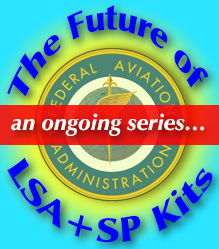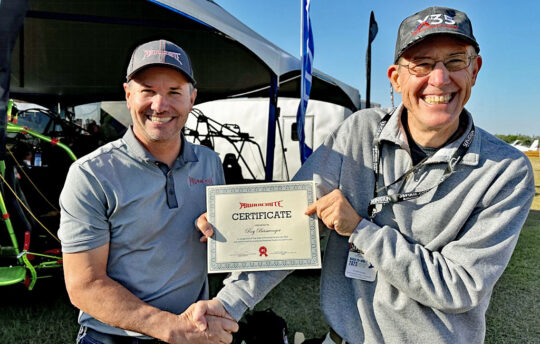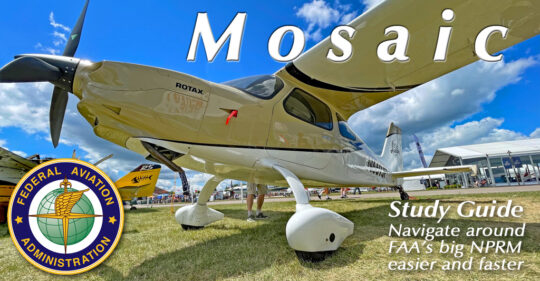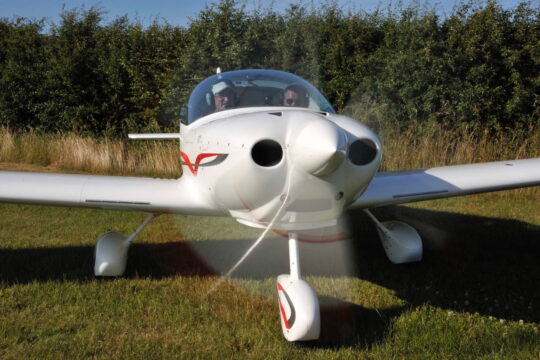OK, so we have a new U.S. President and Trump often promised to “Eliminate 10 new rules for every new one proposed.”
 On the campaign trail, this was only promises, such as every politician makes. Now comes reality. Will our new president do what he said?
On the campaign trail, this was only promises, such as every politician makes. Now comes reality. Will our new president do what he said?
Regular readers will recognize Roy Beisswenger. Roy and I made several trips to Washington, DC in an attempt by LAMA, the Light Aircraft Manufacturers Association, to encourage FAA to make changes to the then-10-year-old Sport Pilot / Light-Sport Aircraft regulation. Our work, starting in 2014, began a few years before anyone knew anything about Mosaic. Being involved for ten years provided lots of knowledge about FAA rule making, leading to actions later known as Mosaic.

Roy Beisswenger (R) receives a dealer award from Galen Geigley of Powrachute.
In his day job, Roy is the proprietor of Easy Flight, the nation’s premiere powered parachute educator and flight trainer. Follow the link to learn more.
To learn more about those advocacy trips, what we asked for, and what was finally included in FAA’s newest rule, follow this Mosaic link. In these articles you can find many other links to speed your review of Mosaic. Government regulations are rarely easy to follow so we attempted in several media forms to bring awareness to what FAA was doing.
Is Mosaic to Be Frozen?
Is a regulatory freeze going to slow the release of Mosaic? Based on what Roy reports in some detail, I believe that is a high likelihood.

LAMA and USUA produced a Study Guide helping pilots uncover what was in FAA’s 318-page proposal.
President Trump just signed an order called, “Regulatory Freeze Pending Review.” Here’s the full White House text. Because the Mosaic rule has not been published yet, it appears probable that the proposed regulation will be halted, at least for a period of review.
Yet that’s not all.
In the Freeze Review Roy notes that it states, “Rules should be looked at after they are published and before they become effective.” Roy added, “This is a major change in the way the federal government publishes rules.


In short, the odds of further delay in Mosaic’s release appears probable. Stay alert!
Roy’s 11-minute video below clarifies much more on this Regulatory Freeze Pending Review…
In the following video, longtime aviation journalist Roy Beisswenger provides background and clarity on a possible Mosaic freeze.
Those that prefer to read what he said or who want to review specifics can find the entire video text below.
Full Text of Above Video
By Roy Beisswenger
January 21, 2025
MOSAIC Paused
It has been widely reported that the MOSAIC rule was expected to be published by the middle of 2025. But, President Trump just signed an executive order freezing the publication of any new federal rules, pending a review. Let’s look at the freshly signed executive order and see how that affects MOSAIC and its timing.
Hello! My name is Roy Beisswenger and by the end of this video you’re going to know what’s in the president’s new executive order called “Regulatory Freeze Pending Review” and how it may affect MOSAIC.
First, some background. MOSAIC stands for Modernization of Special Airworthiness Certification. The FAA describes MOSAIC as
An amendment to the rules for the manufacture, certification, operation, maintenance, and alteration of light-sport aircraft. The FAA says that the proposed amendments would enable enhancements in safety and performance and would increase privileges under a number of sport pilot and light-sport aircraft rules. These enhancements include increasing suitability for flight training, limited aerial work, and personal travel. MOSAIC would expand what aircraft sport pilots may operate.
I’ve gone into depth presenting the details of MOSAIC. The short version is that MOSAIC is overall a pretty good rule, but is flawed as it was presented to the public in the Notice of Proposed Rulemaking or NPRM.
The NPRM was published in the summer of 2023. Yes, that long ago. The comment period came to a close in early in 2024. Since then, the rule has been studied by the FAA with a mind to incorporating or rejecting changes suggested by the public. And there were quite a few suggestions! 1,357 comments to be exact! Many of those comments were different people suggesting the same thing. Some comments probably were conflicting with other comments. I’m sure it was a lot for the FAA to sort out. Then there has been the editing of the rule and the intra-agency process that comes with that, especially since MOSAIC cuts across so many parts of the FAA.
But the work isn’t finished. And even if it was finished, it wasn’t published. That means that the Regulatory Freeze will affect it. Let’s look at the language of the freeze and see what may apply.
The 1st paragraph of the executive order says…
(1) Do not propose or issue any rule in any manner, including by sending a rule to the Office of the Federal Register (the “OFR”), until a department or agency head appointed or designated by the President after noon on January 20, 2025, reviews and approves the rule. The department or agency head may delegate this power of review and approval to any other person so appointed or designated by the President, consistent with applicable law. The Director or Acting Director of the Office of Management and Budget (the “OMB Director”) may exempt any rule that he deems necessary to address emergency situations or other urgent circumstances, including rules subject to statutory or judicial deadlines that require prompt action.
This will delay things simply because it takes time to hire new department and agency heads. First, the candidates have to be found. I’m sure many candidates have already been screened since the election in November. But the process of Senate confirmations has only just begun. I don’t know how high of a priority the department of transportation or the federal aviation administration is for confirmations. But the period may take well over 60 days. In fact, this executive order may be part of President Trump’s leverage to get his candidates for these positions confirmed by the Senate.
After the department and agency heads are selected and confirmed, they have to review all of the new rules. Of course they will have their own teams for that, but it takes time to hire those people. So it will take time to review all of the individual rules.
The 2nd paragraph of the executive order says…
(2) Immediately withdraw any rules that have been sent to the Office of the Federal Register but not published in the Federal Register, so that they can be reviewed and approved as described in paragraph 1, subject to the exceptions described in paragraph 1.
This may or may not affect MOSAIC, I really haven’t checked on where the rule is right now. I believe it’s still with the FAA.
The 3rd paragraph of the executive order says…
(3) Consistent with applicable law and subject to the exceptions described in paragraph 1, consider postponing for 60 days from the date of this memorandum the effective date for any rules that have been published in the Federal Register, or any rules that have been issued in any manner but have not taken effect, for the purpose of reviewing any questions of fact, law, and policy that the rules may raise. During this 60-day period, where appropriate and consistent with applicable law, consider opening a comment period to allow interested parties to provide comments about issues of fact, law, and policy raised by the rules postponed under this memorandum, and consider reevaluating pending petitions involving such rules. As appropriate and consistent with applicable law, and where necessary to continue to review these questions of fact, law, and policy, consider further delaying, or publishing for notice and comment, proposed rules further delaying such rules beyond the 60-day period.
This paragraph seems to be pretty big to me. Why? Because it signals a new way of doing business. What the president is saying here is that rules should be looked at after they are published and before they become effective. This is a major change in the way the federal government publishes rules. The way it currently works is that Rules are proposed. There is a discussion between the government and the public. Then there is a time while the FAA huddles and writes the proposed rule. When that’s done, the government publishes a notice of proposed rulemaking. Then there is a comment period. That comment period is usually the main opportunity for the public to comment on a proposed rule. After the comment period is over, the FAA or whatever organization goes into hiding and writes the rule without any outside interference. At least allegedly. Then the rule is published. After the rule is published, there is no opportunity for the public to comment or change the rule without starting the whole process over again. In the case of Sport Pilot, it took over a decade to even start the process. In fact it is already twenty years since sport pilot first became a rule and we are just now getting close to finally, hopefully, solving some of the problems with the original rule.
What the president seems to be saying here is that the public gets another chance to respond to a rule before it becomes an active rule. This could be a big deal that will affect all kinds of rules coming from the federal government. For MOSAIC, it means that there are probably a lot of things that the FAA really wants in the rule but the public doesn’t want. If the FAA has to publish the rule and then go through another comment period, this could slow down the effective date of the rule.
Of course this may be just a temporary process to slow down potentially bad rules that have already been published but aren’t quite effective yet.
I have to say that I would like to see this become a regular part of the rulemaking process. In the case of the FAA, it would give pilots, aircraft manufacturers and other interested parties a chance to hold the FAA accountable for their final rulemaking products. I remember back when the Sport Pilot rule was first published. The preamble of published rules is where the FAA addresses comments from the general public. I and others made several suggestions. Many of my suggestions were based on observations from Australian pilots who already had a similar system in place. They warned me that several aspects of the Sport Pilot rule would really hurt Powered Parachutes. They were speaking from experience.
Ultimately, the FAA never really addressed those concerns. All they said was that the FAA does not concur. As it turns out, I was right about the effects Sport Pilot would have on powered parachutes and the FAA was wrong. But there never has been any accountability. And there never was a chance to ask the FAA what reasoning they had behind the statement, “The FAA does not concur.”
The FAA also said at the time that it did not concur that gyroplanes should be allowed to be manufactured as special light sport aircraft. That mistake is taking 21+ years to correct, and it still isn’t yet officially corrected.
Personally, I don’t believe that any agency should be able to say that they don’t concur with a public comment without some kind of justification. Saying “the FAA doesn’t concur” seemed arrogant and dismissive at the time, especially since the FAA turned out to be dead wrong.
Perhaps allowing another comment period after the rule was published would have prevented some of that.
An ability to challenge a federal agency AFTER a rule is published is a big positive that may slow things down in the short term, but will make the FAA and the rest of the government more responsive to the public in the future. What do you think? Should the rulemaking process be more responsive to the public or are things just fine as is? Let me know in the comments.
The 4th paragraph of the executive order says…
(4) Following the postponement described in paragraph 3, no further action needs to be taken for those rules that raise no substantial questions of fact, law, or policy. For those rules that raise substantial questions of fact, law, or policy, agencies should notify and take further appropriate action in consultation with the OMB Director.
This means that MOSAIC could sail swiftly through the process. But I don’t know that it will. I can see some things being challenged, like the FAA’s discrimination against aircraft they don’t fully understand like gyroplanes, powered parachutes, and weight-shift control trikes. Then there is the arbitrary and unnecessary new rules on light sport aircraft noise, which was literally put in there because they could. Not because there was a demonstrated need. That unnecessary rule will cost manufacturers and the public money to conform to.
The 5th paragraph of the executive order says…
(5) Comply in all circumstances with any applicable Executive Orders concerning regulatory management.
This is a catchall that seems to imply that more is coming. Overall, this may be a very good thing. Perhaps this will motivate the FAA to reconsider public comments, especially the ones that point out real flaws in MOSAIC. Hopefully, “The FAA does not concur” will be augmented with real reasons, if those real reasons even exist.



I think one thing that was missed in Mosaic, which I forgot as well, was that Sport CFI-S training should count towards private pilot. You are tested to the same standard exactly for your private and sport pilot certificate. The only difference is IFR, night and a longer cross country. This would open up opportunities for a CFI-S. Dan you should mention this to the FAA.
It has been mentioned to FAA on multiple occasions. We don’t know enough about the pilot and operating limitation of Mosaic — we know lots about the aircraft but the other shop inside FAA has been far less accommodating. At this point, the window is closed for input. Let’s see what we get in September (we hope).
Any update on MOSAIC delivery date Dan ?
In mid-March 2025, some with inside connections say it is not likely FAA will announce Mosaic at Oshkosh this summer. This allows time for the agency to be sure they meet the requirements of the new administration and its regulation reduction effort. The good news is… the delay should not be long.
Thank you, Dan, for all your efforts to make MOSAIC come to fruition. Many of us have been waiting patiently for this to FINALLY happen. I for one don’t care who the current administration is or what side of the political fence they are on. I am losing patience, so I suggest GAMA, AOPA, EAA and everyone else who has been advocating for GA remind the FAA that Congress made a mandate by passing the FAA Reauthorization Act of 2024 (Public Law 118-63) which states:
Section 824: MOSAIC rulemaking deadline
The much-discussed MOSAIC decision is due within 24 calendar months. Many expect a decision prior to the deadline, but at the very least, a final ruling on the Modernization of Special Airworthiness Certification will occur in 2026.
Are we still a country of law and order? Well, I guess time will tell! Thank you!
I know your question is probably rhetorical, but no, we are not.
Don’t hold your breath. Even things as simple as Aircraft registrations have been delayed by months because of all of the upheaval in the FAA with the shotgun approach to firings. Just my opinion, but you won’t likely see MOSAIC until well into 2026, if ever.
I was around when Dan started LAMA and commend him in staying the course and helping GA. Hard to believe it has been 20 years. Sebring was so inspiring and held great opportunity. But alas, I have grown old, now 68, and my candle flame is nearly extinguished for flying. This latest delay is the end for me. My dad introduced us kids to flying nearly 60 years ago, with a Piper Tripacer and Comanche. Flying flew thru my blood as it does many others. But, the FAA really are just not our friends and prefers we go away quietly. And I will I will miss those beautiful days up in the deep blue skies. I wish all you wonderful dreamers the best!
Bob Perkins
Cardinal Marketing (RIP)
A modest correction: Larry Burke and a few others fouded LAMA, the Light Aircraft Manufacturers Association. I was its president and chairman for 20 years but it began 20 years earlier.
That said, your message was poignant and thanks for your kind words of support.
Bob, I’m not too far behind you and feel the same way about the clock winding down. I just want to be able to fly the entry level Part 23 Cessna and Piper aircraft that I trained in when I was younger today under MOSAIC with a Sport Pilot’s license.
I think MOSAIC is dead. With the focus on air safety, the idea that the FAA will relax rules under the current administration is zero. No bureaucrat is going to make that call.
I sadly agree with you.
I started as a student pilot this year with the intention of obtaining a Sport Pilot license. I am currently learning in a Cessna 172 with the thinking MOSAIC would go through in July.
Now I believe MOSAIC is dead or delayed for years. I’m also attending aviation ground school. My alternative appears to be to purchase an LSA before I have a license and find a CFI licensed and willing to train me in it.
Not likely, but I guess we all have our own opinions. We will just have to wait and see. Personally I don’t see how adding more regulation to the regulations is less regulation, but I have never been great with math. And by the way, by the “former administration,” does that include the administration from 2016 to 2020?
I always said Mosaic would probably be mid-2026. I hate to admit I’m wrong but it looks like ’27 or ’28 if ever. Like they say, be careful what you wish for because there are always unforeseen circumstances. Mr T.
“An ability to challenge a federal agency AFTER a rule is published is a big positive that may slow things down in the short term, but will make the FAA and the rest of the government more responsive to the public in the future. What do you think?”
What am I missing here? All that this proposal is going to do is add another layer of time consuming bureaucracy on top of everything else. Public comments have already been made and considered. This rule will simply allow people to rehash the same comments that they have already made the first time around, with likely no change to the final rule. It seems to me that once the rule has been written there is absolutely no obligation or desire on the part of the regulators to change it. It is a HUGE NEGATIVE and will just slow down the process, with absolutely no benefit to the public.
Add to that all of the jobs that are about to be cut, and nothing will ever get done.
Let hope this was done as a way to stop the present administration from doing the backdoor blocking of the new administration policy’s, examples, the present administration changing policy to prevent the new administration from firing and rehire new judges as has always been in the past. Not to make it political, but it is political. The outgoing administration is trying their best to subvert the will of the people from the election because they are angry they lost.
Thanks for taking the time to analyze and report. Greatly appreciated. Trump’s objective to look at new regulations is for the better to make sure we are not over regulated, MOASIC may be affected even though it is a regulation for less government regulation. Maybe this will be understood or maybe not we shall see.
I’m gonna gut the FAA and deregulate it as much as possible for my friend Elon so he can blow up more rockets.
Well, maybe I’m wrong, but I am still hoping to see this announced at AirVenture. I have a couple reasons for why I still hope for this.
First off, President Trump is the one who signed the 2018 FAA Reauthorization bill into law, and that law called for this regulation change to happen by the end of 2023. I’m not sure if or how much that matters, but it could be a factor.
Second, with the increase in sport pilot priviliges, as well as moving “certification” of some light aircraft out of the FAA and into ASTM standards, this regulation change could actually be viewed as a reduction in regulation, which is one of Mr. Trump’s goals.
Third, there is a statutory deadline, both in the Reauthorization bill of 2018 (for the rule to be enacted by the end of 2023), and in the most recent Reauthorization bill (for the rule to be enacted by the end of this year). That statutory deadline is one path of OMB exemption.
We’ll see what happens with the secondary comment period. I do agree that this is a good idea, and would like to see it become the regular way of doing business.
These are a couple factors that I’ve thought of. How it plays out? We’ll see.
A lot of people think there is an Easter Bunny. Mosiac 2050. I’m sure glad I keep myself healthy and physically fit.
I can’t imagine a dumber comment.
No surprise here! This is exactly what I wrote would happen a couple of months ago if Donald Trump became President. Why is anyone shocked? What did you expect! I will even go one further. MOSIAC will be buried under this administration and will never see the light of day for the next four years.
I think you have it backwards. If the former administration was serious about their responsibilities under the law, they would have met the 2023 deadline. They weren’t and they didn’t. This new administration is a much more favorable environment for deregulation and regulatory modernization. Unfortunately, while there may be some transition delays, the MOSAIC program regs will be better than ever after following this executive branch direction.
Exactly.
Time will tell. These changes are already delaying it. The question now is how long….
Prior to Feb 17 2025 the average turnaround time for a registration application was 3.5 weeks. The FAA received my application on Feb. 10 on Feb 17th the mass layoffs occurred at the FAA. I am now at 7 weeks. Twice as long as before the layoffs with no end in sight. Make America Great Again? Half as efficient as they were before. Not to mention thousands of upon thousand added to the unemployment lines. Now we really will have to pay them for not working.